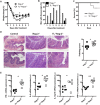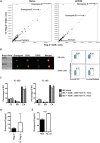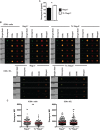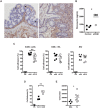Innate CD8αα+ lymphocytes enhance anti-CD40 antibody-mediated colitis in mice
- PMID: 28474503
- PMCID: PMC5418141
- DOI: 10.1002/iid3.146
Innate CD8αα+ lymphocytes enhance anti-CD40 antibody-mediated colitis in mice
Abstract
Introduction: Immune responses in the intestines require tight regulation to avoid uncontrolled inflammation. We previously described an innate lymphocyte population in the intestinal epithelium (referred to as innate CD8αα+ , or iCD8α cells) that can protect against gastrointestinal infections such as those mediated by Citrobacter rodentium.
Methods: Here, we have evaluated the potential contribution of these cells to intestinal inflammation by analyzing inflammation development in mice with decreased numbers of iCD8α cells. We also determined the potential of iCD8α cells to secrete granzymes and their potential role during inflammatory processes.
Results: We found that iCD8α cells play a pro-inflammatory role in the development of disease in a colitis model induced by anti-CD40 antibodies. We further found that the effects of iCD8α cells correlated with their capacity to secrete granzymes. We also observed that the pro-inflammatory properties of iCD8α cells were controlled by interactions of CD8αα homodimers on these cells with the thymus leukemia antigen expressed by intestinal epithelial cells.
Conclusions: Our findings suggest that iCD8α cells modulate inflammatory responses in the intestinal epithelium, and that dysregulation of iCD8α cells effector functions may enhance disease. We propose that one of the mechanism by which iCD8α cells enhance inflammation is by the secretion of granzymes, which may promote recruitment of infiltrating cells into the epithelium.
Keywords: Granzyme; innate CD8ɑɑ cells; intestinal inflammation; intraepithelial lymphocytes.
© 2017 The Authors. Immunity, Inflammation and Disease Published by John Wiley & Sons Ltd.
Figures








Similar articles
-
Innate CD8αα+ cells promote ILC1-like intraepithelial lymphocyte homeostasis and intestinal inflammation.PLoS One. 2019 Jul 10;14(7):e0215883. doi: 10.1371/journal.pone.0215883. eCollection 2019. PLoS One. 2019. PMID: 31291255 Free PMC article.
-
CD8αα⁺ innate-type lymphocytes in the intestinal epithelium mediate mucosal immunity.Immunity. 2014 Sep 18;41(3):451-464. doi: 10.1016/j.immuni.2014.08.010. Epub 2014 Sep 11. Immunity. 2014. PMID: 25220211 Free PMC article.
-
Transcription factor c-Rel plays a crucial role in driving anti-CD40-mediated innate colitis.Mucosal Immunol. 2015 Mar;8(2):307-15. doi: 10.1038/mi.2014.68. Epub 2014 Aug 6. Mucosal Immunol. 2015. PMID: 25100292
-
CD8αα TCRαβ Intraepithelial Lymphocytes in the Mouse Gut.Dig Dis Sci. 2016 Jun;61(6):1451-60. doi: 10.1007/s10620-015-4016-y. Epub 2016 Jan 14. Dig Dis Sci. 2016. PMID: 26769056 Review.
-
TL and CD8αα: Enigmatic partners in mucosal immunity.Immunol Lett. 2010 Nov 30;134(1):1-6. doi: 10.1016/j.imlet.2010.09.004. Epub 2010 Sep 17. Immunol Lett. 2010. PMID: 20850477 Free PMC article. Review.
Cited by
-
Diverse developmental pathways of intestinal intraepithelial lymphocytes.Nat Rev Immunol. 2018 Aug;18(8):514-525. doi: 10.1038/s41577-018-0013-7. Nat Rev Immunol. 2018. PMID: 29717233 Free PMC article. Review.
-
Cdx2 regulates immune cell infiltration in the intestine.Sci Rep. 2021 Aug 4;11(1):15841. doi: 10.1038/s41598-021-95412-w. Sci Rep. 2021. PMID: 34349205 Free PMC article.
-
Intraepithelial lymphocytes in human oral diseases.Front Immunol. 2025 May 8;16:1597088. doi: 10.3389/fimmu.2025.1597088. eCollection 2025. Front Immunol. 2025. PMID: 40406112 Free PMC article.
-
Osteopontin and iCD8α Cells Promote Intestinal Intraepithelial Lymphocyte Homeostasis.J Immunol. 2020 Apr 1;204(7):1968-1981. doi: 10.4049/jimmunol.1901168. Epub 2020 Feb 26. J Immunol. 2020. PMID: 32102904 Free PMC article.
-
Intraepithelial lymphocytes in the pig intestine: T cell and innate lymphoid cell contributions to intestinal barrier immunity.Front Immunol. 2022 Dec 8;13:1048708. doi: 10.3389/fimmu.2022.1048708. eCollection 2022. Front Immunol. 2022. PMID: 36569897 Free PMC article. Review.
References
-
- Cheroutre, H. , and Lambolez F.. 2008. Doubting the TCR coreceptor function of CD8alphaalpha. Immunity 28:149–159. - PubMed
Publication types
MeSH terms
Substances
Grants and funding
LinkOut - more resources
Full Text Sources
Other Literature Sources
Research Materials

